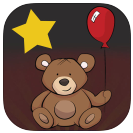TIPS AND TRICKS FOR VISION THERAPY TREATMENT
Day-to-day life with adhesive and fabric eye patches
Vision therapy using adhesive and fabric eye patches can be an arduous task for many, especially if the child resists. We have put together a list of tips and tricks that we have benefitted from or that have been recommended by others who have been through the same process of vision therapy treatment.
On the page ’Motivation’ you can find inspiration for how to best motivate your child to wear their eye patch. Additional tips and tricks can be found below.
Make it natural
As a parent, you should try not to be embarrassed about the fact that your child has to wear an eye patch, since very often this will have an effect on the child. Instead, you should concentrate on making it seem very natural to wear an eye patch by making everyday tasks in day-to-day life seem as normal as possible – both at home and out and about. You will likely experience that strangers take an extra look at children who are wearing adhesive eye patches, and maybe even ask questions. If you offer an honest answer to such questions, your child will gradually learn the reason why they have to wear the eye patch and will eventually be perfectly at ease with this reality.
Let the child know why the eye patch is needed
Children deserve to have an explanation as to why they have to wear an adhesive eye patch, if they are old enough to understand. But of course, the way in which they are told should relate to their respective age. Personally, we formulate it in phrases, such as ‘Alma wears her eye patch to give her better eyesight,’ if other children ask.
Fixed routine
A fixed routine can make it easier to implement using an adhesive eye patch in daily life. Personally, we have got into the routine of putting the eye patch onto our daughter as soon as she wakes up. In doing so, we get her daily vision therapy over and done with before it is too late in the day, so we avoid the hassle of trying to get our daughter to cooperate when she is tired after a long day. Some people apply the adhesive eye patch just before the child wakes up in the morning so that the child doesn’t consciously experience their eyesight being taken from them, as the case is when the child is wide awake and using both eyes.
Your child’s day-care centre can be included in the child’s daily routine. Personally, we found it was easier to reach our goals regarding eye patch training, if our daughter got it done whilst at nursery. It just became a part of her fixed daily routine, which she had been used to anyway. As a result, we don’t have to struggle with getting her to do it in the afternoon and evening after a long, tiring day.
Our daughter always has a reward poster hanging on her bedroom wall, which she sticks her eye patch onto at the end of every day when eye patch training is done. Our reward poster can be viewed in the category ‘Motivational products’.
Celebrate good news
Something that has proven successful for us has been to celebrate smaller milestones, such as when our daughter has been to a check-up at the Kennedy Centre (National Centre for Research and Advice regarding genetics, visual impairment, and mental retardation) and they have noticed positive progress, even though our daughter is too young to understand this. We involve her siblings in the festivities, since they are also part of her everyday life wearing an eye patch e.g., they notice if she has taken her eye patch off.
Bringing in a cake to the nursery has also proven to be a good way of going about things. The staff there are equally responsible for her positive progress as we are, since our daughter often wears her eye patch during the day, whilst she is at nursery. Day-care institutions are generally very important in terms of reaching your therapy treatment goals.
I have also heard that some people like to celebrate their child’s progress with their child’s friends by having a party at the kindergarten. Activities that can be enjoyed by the children at the party could be, for example, decorating eye patches, putting the eye patch on the pirate, whilst the children themselves are wearing an eye patch (just like when playing ‘pin the tail on the donkey’).
Rewards/Motivation
Some parents find it helps to motivate their child to wear their eye patch if they are rewarded for their efforts. View the section ’Motivation’ and let yourself be inspired.
Kindergarten/Nursery
If you child’s course of vision therapy treatment requires them to wear their adhesive eye patch at home, as well as at kindergarten or nursery, then the staff at the institution have an important role to play in terms of your child’s vision development. The staff at our daughter’s nursery do such a wonderful job of ensuring that she wears her eye patch, meets her goals that we set every day for her, and register the number of hours she is awake and the number of hours wearing the eye patch. Every now and again, the gift of a cake is very much appreciated by the staff as recognition of their great work. 😉
Skin Irritation
If you child is dealing with skin irritation problems as a result of using an adhesive eye patch, then read our tips for prevention on the page: ‘Skin irritation‘.
Arm restraints
Abroad, it is possible to buy arm restraints, which are put onto the child’s arms to prevent them from bending their arms, so they are unable to take their eye patch off. However, at Vision4kids we do NOT recommend using them. As an alternative, I have heard other parents have found it useful to put armbands on their children if they are very young, so it is harder for them to touch their eye patch.
Computer games/apps
Some parents choose to let their children play on the computer/iPad at the same time as having to wear their adhesive eye patch. This is a recommendation we were given by the Kennedy Centre (National Centre for Research and Advice regarding genetics, visual impairment and mental retardation), when our daughter was seven months old.
After having contacted a Danish organisation for Sight, I managed to collate the following list that can help to stimulate your child’s vision (suitable for children from 0-18 months).






